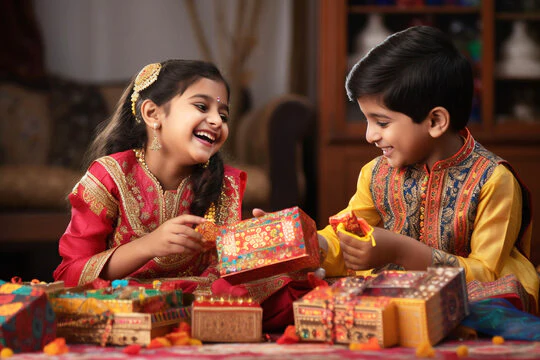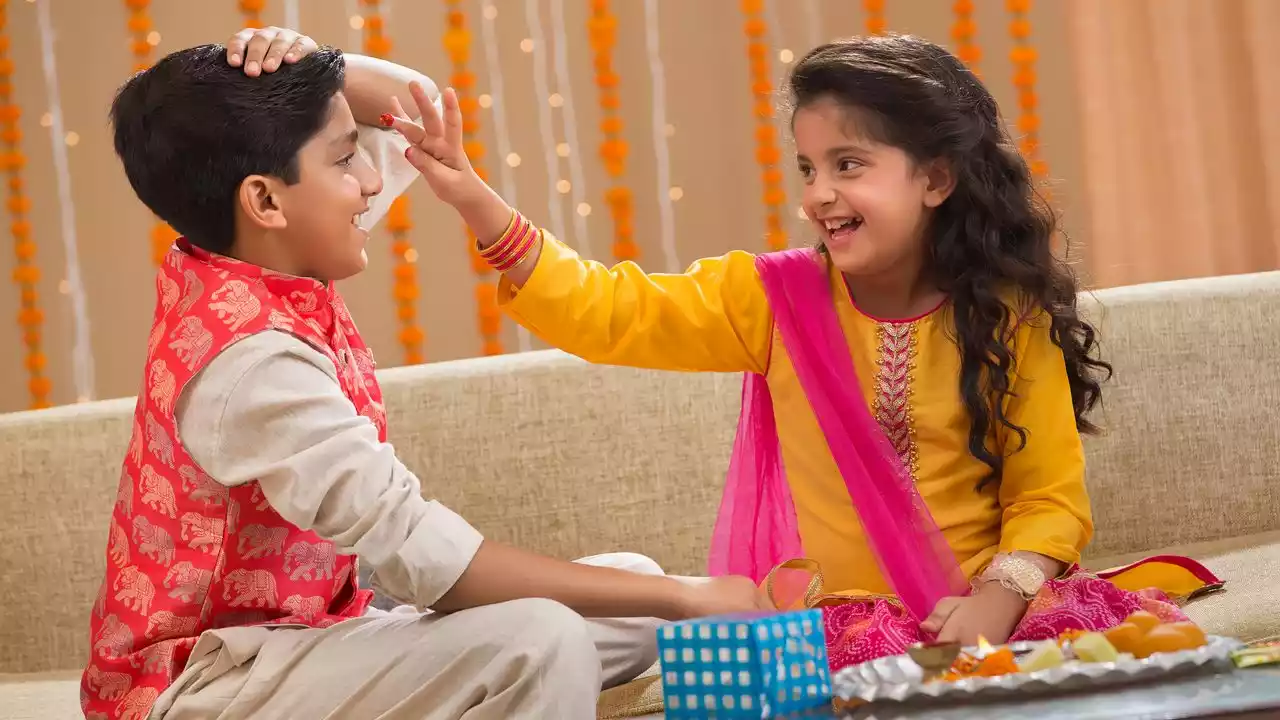Bhai Dooj or Bhai Phonta (also known as Bhai Tika or Bhai Dwitiya, depending on the region) is a cherished Hindu festival that celebrates the bond between brothers and sisters.
At its heart, the festival is a gesture of love, protection, and blessings: sisters perform a special ritual for the welfare of their brothers. Also, brothers, in turn express their commitment to look after their sisters.
The festival typically falls on the second lunar day (Dwitiya) of the bright fortnight (Shukla Paksha) in the Hindu month of Kartik.
 Join Now
Join Now
What is Bhai Dooj?
Mythologically, one of the most well-known stories ties it to Yama (the god of death) and his sister Yamuna. When Yama visited Yamuna on this day, she welcomed him with ritual hospitality and applied tilak on his forehead.
Yama, touched by the gesture, granted a boon of long life to her and all her brothers who received similar blessings.
In this way, Bhai Dooj bridges devotional, familial and cultural themes: the idea of a brother’s protection. Also a sister’s good wishes, divine blessings and communal warmth.
Bhai Dooj Date & Timing (Muhurat) for 2025
For 2025, the key information is:
Bhai Dooj will be celebrated on Thursday, 23rd October, 2025
According to the Panchang or Hindu calendar, the Dwitiya Tithi (second lunar day of Shukla Paksha in Kartik) begins at 08:16 PM on 22nd October, 2025 and ends at 10:46 PM on 23rd October, 2025
The most auspicious window (muhurat) for applying the tilak and conducting the main rituals is indicated as around 1:13 PM to 3:28 PM on 23rd October 2025.
Additional sources mark the “aparahna” (afternoon) time of 12:48 PM to 3:24 PM as favorable.
Pro Tip:
If you plan to celebrate, it helps to check the local Panchang or speak to a priest in your region because timings may vary slightly depending on your city.
Bhai Dooj Rituals and How It’s Celebrated
Though the core themes remain the same, Bhai Dooj is observed with some regional variety across India. Here’s a general ritual flow, followed by regional highlights.

Very Common Rituals
Preparations
Sisters prepare a puja thali (plate) which typically includes a diya (oil/ghee lamp), roli, akshat (rice grains), sweets, fruits, sometimes coconut and betel leaves.
Tilak & Aarti
The sister applies a tilak (mark) on her brother’s forehead, offers him aarti (circling of the lamp), prays for his long life and well-being, and often feeds him something sweet. The brother, in return, gives gifts or money and promises to look after his sister.
Feast & Gifts
The day becomes an occasion for family gatherings, special meals, sweets and the exchange of gifts. Even if siblings live far apart, modern variations include virtual calls and sending gifts by post.
Blessings & Good Wishes
Beyond the ritual, the festival emphasizes the intangible: love between siblings, gratitude, and a sense of responsibility towards each other.
Regional Variations Across in India
- In Bengal, it is called Bhai Phonta. Sisters apply tilak (phonta) and feed their brothers with sweets; the mood is similar though the names differ.
- In Maharashtra & Gujarat, the term used is Bhau Beej. Here too, the rituals of tilak, treats and gift-giving prevail.
- In Nepal, the festival is known as Bhai Tika during the Tihar festival. Sisters give a colourful multi-layered tika, garlands, sweets and blessings to their brothers.
- In some places, the festival is called Yama Dwitiya, emphasizing the legend of Yama and Yamuna.
These regional forms show how a common theme adapts to local culture, language and tradition.
Bhai Dooj Cultural & Emotional Significance
Strengthening sibling bonds
Although the festival is rooted in myth, its lasting value lies in reinforcing real-life relationships. Sisters actively pray for their brothers’ welfare and brothers acknowledge their role of care.
In a fast-moving world, the day becomes a conscious pause to reflect on those ties.
Family unity & communal mood
Bhai Dooj often rounds off the multi-day Diwali celebration, a time when families gather, festive meals are shared and the general rhythm slows down to emphasize togetherness.
It becomes a sweet, quieter counterpart to the sparkle of the other Diwali days.
Blessings & the idea of protection
The myth of Yama and Yamuna injects a spiritual dimension: the idea of overcoming fear of death, of separation through duty, love and ritual.
In many households, the tilak is seen as not just symbolic but protective and blessing-filled.
Cultural continuity
In modern India – even among families separated by cities or countries – Bhai Dooj remains a moment when traditions are renewed.
It offers a bridge between generations: children learn the rituals; parents remember their own childhoods; siblings who live apart make special plans.
Pro Tips for Celebrating Bhai Dooj 2025
1. Prepare the puja thali in advance: ensure you have roli, akshat, a diya (lamp), sweets of choice, fruits and any local custom item (e.g., coconut, betel leaves).
2. Make it meaningful: instead of just a gift out of routine, try choosing something your sibling will appreciate – even a simple handwritten note or a small plant can carry meaning.
3. If siblings are far away: Consider a video call during the tilak ceremony; you could mail or send a photo of the thali, share sweets via delivery, or schedule a virtual meal together.
4. Embrace the regional flavour: If you belong to a certain state, include that state’s version of celebration (for example, in Bengal serve certain local sweets; in Maharashtra include special dishes your family enjoys).
5. Use the day to reflect: Take a moment to express gratitude — thank your siblings for being part of your life, share a memory, or plan a future meet-up.
6. Keep the atmosphere festive but grounded: While gifts and sweets are part of the day, the warmth and connection matter most.
Why Bhai Dooj Matters in 2025 and Beyond
In today’s fast-moving life, work and digital lives often keep families apart, festivals like Bhai Dooj serve as anchors. They remind us of relationships that aren’t transactional but rooted in care and continuity.
At a cultural level, this festival also keeps alive the older ways of looking after each other – siblings, extended family, community — in an era increasingly focused on the individual.
Finally, as families become more diverse (through marriage, relocation, blended households), Bhai Dooj can evolve too: friends who are like siblings can take part. Cousins far apart can plan online celebrations.
Traditional rituals can be adapted while keeping the spirit intact. Celebrating Bhai Dooj means more than applying a tilak or exchanging gifts.
Wishing you a joyful and meaningful Bhai Dooj 2025. May the bond you share with your siblings shine brightly and bring blessings.

